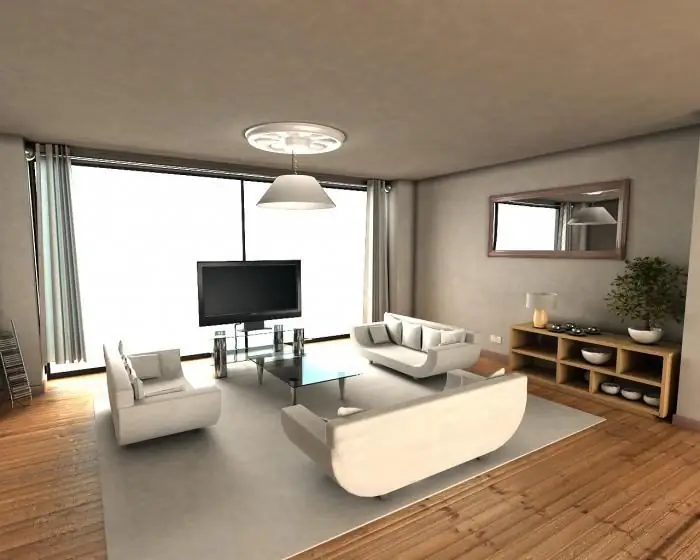2026 Author: Howard Calhoun | [email protected]. Last modified: 2025-01-24 13:10:43
Humanity has used faience to make plates and cups since ancient times. And in the modern world, ceramic dishes are considered almost indispensable. Although the style of products, the technology of their production is constantly changing, but the material itself remains unchanged. What is earthenware, and what features does it have - let's try to figure it out in this article.
What is earthenware
Faience is a material from which dishes, interior items, architectural elements, etc. are made. It is characterized by fragility, density and fine porosity. The name of this material comes from the Italian city of Faenza, which was famous for the production of ceramic products.
Faience is mainly used for the production of tableware, souvenirs and various ceramic gifts. Figurines of this type differ from porcelain figurines in brightness and saturation of colors and look very fabulous. As for cutlery, faience dishes are most often made in a simple form and look ordinary. It is ideal for everyday usefood with simple table setting.

Varieties of faience
Depending on the composition and amount of impurities, there are several types of faience:
- Lime faience - in addition to quartz and white clay, the composition includes chalk and dolomite. Thanks to these additives, products are made much easier and faster.
- Soft earthenware - various fluxes are added to the traditional composition - substances that form fusible compounds during thermal processing.
- Feldspar faience - it contains a certain amount of feldspars (rock-forming minerals).
- Hard faience is the most durable material. Such products are characterized by high mechanical characteristics. Hard faience is fired at a very high temperature.
History of faience
Mankind knew what faience was, even 4 thousand years BC. e. The composition of the first ceramics was slightly different from that produced today. In Mesopotamia and Egypt, faience products were made from quartz pebbles with impurities of soda, limestone, copper and iron ore.
Much later faience appeared in the Old World. At first it was produced under the name majolica in some cities of Italy. Then high quality faience products were produced in France, in the city of Saint-Porche.
In Russia, faience became famous in the 18th century. Entire factories for the production of ceramic products worked in Moscow. Faience ware dispersed among the population at a high rate and enjoyed incredible popularity. Products from different factoriesdiffered from each other. So, the masters of the Grebenshchikov manufactory painted dishes on raw enamel. The faience of the Kuznetsov Partnership was distinguished by multi-colored glazes, three-dimensional reliefs or printed drawings. The Gzhel factory produced products mainly in blue, as well as with gold painting.
Konakovo faience

M. S. Kuznetsov made a great development in the production of faience products, who bought out a porcelain factory in the city of Konakovo in 1870. He produced mainly hand-painted or printed faience dishes. About 20 years later, Kuznetsov began to produce dishes from semi-faience, porcelain and ceramics. Since the mid 20s. In the 20th century, the plant began to attract the best artists and masters of painting to create beautiful drawings on dishes and create animalistic sculptures. Their works were in demand, which, in turn, contributed to the expansion of production.
Over time, the artists managed to create a certain style for their products: faience objects, organic in form, played with cheerful bright painting and dripping glaze. Konakovo faience was exported to many countries. Some products have been safely preserved to this day.
Semikarakorsk pottery

Semikarakorsky faience is a bright artistic phenomenon of the Don land. The Rostov region has been manufacturing ceramics since ancient times. Many archaeological finds testify to the existence of handicraft pottery workshops inSemikarakorsk since pre-Christian times.
The artistic style of Semikarakorsk faience is distinguished by original painting, bouquet and floral ornaments, natural scenes, and historical motifs. Masters in their drawings managed to convey all the beauty and power of their region, Don traditions, the spirit of the Cossacks.
Due to the high level of artistic craftsmanship, Semikarakorsky faience is considered a work of art all over the world.
Types of faience products
Faience is used almost everywhere these days. This is due not only to its low cost, but also to the ease of manufacture of such products. Most often, dishes are made from faience: salad bowls, plates for snacks and main courses, deep bowls, herring bowls, coasters for bread and confectionery, gravy boats, bouillon vases and tureens, cups for hot drinks, milk jars, mugs, s alt shakers and sugar bowls. Often these days in stores you can see a large assortment of architectural elements made of faience, tiles, toilet bowls. Such interior items testify not only to the good taste of the owner, but also to his financial well-being.
How earthenware is made
To create faience, two components must be used: quartz and refractory white clay. The manufacturing process of a ceramic product begins with the processing of the latter. So, the clay mass is fired several times at a temperature of 1050 ºС, during which it should change color. Then, at a temperature of 950 ºС, a colored or transparent glaze is applied. At the final stage, a repeatedburning. As a result of such an impact, the faience mass remains porous and suitable for decorating with drawings. If faience is fired at low temperatures, it will retain intense underglaze colors better.
Thus, the material goes through many stages of processing until the finished faience is obtained. A photo of the plate making process illustrates the subtlety of this process.

Faience sanitary ware
Recently, faience sanitary ware has become increasingly popular. Its production takes place according to a different technology than the manufacture of dishes or figurines. To create a high strength of the material, the products are coated with a special glaze. With proper and careful operation, faience sanitary ware can last for a long time, while it will look the same as at the time of purchase.

How to distinguish earthenware from porcelain
Many do not know the difference between porcelain and faience, and are often confused, although there is a certain difference between them. Earthenware products are characterized by a low degree of whiteness, greater wall thickness and less strength. Finished items are distinguished by smooth shapes. Earthenware dishes, compared to porcelain, are unable to retain heat for a long time. In addition, such products do not withstand high temperatures. If the dishes are washed in hot water, they may crack. Therefore, in many cases it is more practical to use porcelain cutlery.
To understand well how porcelain differs from faience, you can spendcomparison of products from these materials. The first and most important difference is the sonority of the subject. It is necessary to tap lightly on the edge of the plate. The porcelain product will emit a long and distinct rumble. At the same time, the faience will ring with a dull sound.

Faience can also be identified by external signs. The dishes made of this ceramic do not transmit light at all. This is due to the fact that the products are fired at a relatively low temperature. A significant difference is the smooth bottom surface of the dishes. Sometimes you can see small depressions that formed during firing. In comparison, the bottom of porcelain is always rough.
Owners of earthenware should be more careful with it and monitor its condition. If cracks appear, it is undesirable to use such products, since pathogenic bacteria penetrate into the pores of faience and can provoke the development of various diseases.
How to care for faience
Like any crockery, earthenware requires some care. Given all the properties of this material, it is very important to follow the rules of operation in order to extend the life of faience.
The most important rule is that faience products can only be washed in warm water, and rinsed in cold water. If hot water is used, small cracks form on the dishes, and the structure of the material is disturbed.

Detergents, especially powders, should not be used. To lighten darkened faience dishes, you can use a solution of baking soda or s alt with vinegar in the ratio1:1. Particular care should be taken with gold-plated products. The fact is that the drawings with which the faience products are decorated are covered with glaze. Therefore, after repeated washing, they remain in their original form. As for the gilding, it is applied over the glaze and is gradually erased from regular use. Therefore, places decorated with gold paint should not be rubbed hard; it is better to use a soft cloth or sponge. You can remove stains from faience products with a cloth dipped in a small amount of ammonia.
Despite the advantages of porcelain, people still continue to buy faience. This encourages ceramic manufacturers to produce new products for a variety of purposes.
Recommended:
What is the difference between a tour operator and a travel agency: concept, definition, difference, functions and characteristics of the amount of work performed

The words "travel agency", "travel agency", "tour operator" seem similar to some people. In fact, these are different concepts. To understand them and not get confused anymore, we suggest today to study how a tour operator differs from a travel agency and a travel agency. This knowledge will be especially useful for those who are planning a trip in the future
What is the difference between a lawyer and a lawyer, what is the difference? How a lawyer differs from a lawyer - main duties and scope

People often ask such questions: "What is the difference between a lawyer and a lawyer?", "What is the difference between their duties?" When life circumstances arise, when it is necessary to turn to representatives of these professions, you have to figure out who is needed in a particular situation
What is the difference between an apartment and an apartment? The difference between an apartment and an apartment

The residential and commercial real estate market is incredibly vast. When offering housing, re altors often refer to an apartment as an apartment. This term becomes a kind of symbol of success, luxury, independence and we alth. But are these concepts the same - an apartment and an apartment? Even the most superficial glance will determine that these are completely different things. Consider how apartments differ from apartments, how significant these differences are, and why these concepts should be clearly distinguished
What is better to open: LLC or IP? Pros and cons of sole proprietorship and LLC. The difference between sole proprietorship and LLC

What is better to open: LLC or IP? Having decided to throw off the shackles of office slavery and no longer work "for your uncle", developing your own business, you should know that it must be legal from a legal point of view
What is the difference between a guarantor and a co-borrower: detailed description, features, difference

Those who have not applied for a bank loan, the concepts of "guarantor" and "co-borrower" may be perceived in the same way, although this is far from the case. Having understood these concepts, you will know what responsibility each of the participants in the transaction bears to the bank. What is the difference between a guarantor and a co-borrower? What do they have in common?

